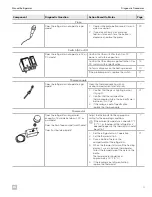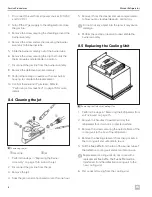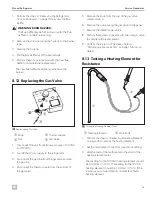
4
EN
Intended Use
• This product is equipped with a three-prong
(grounding) plug for protection against shock
hazards. This product should be plugged directly into
a three-prong receptacle that provides grounding in
compliance with all applicable electrical codes. Do
not
cut or remove grounding prong from plug.
• Before refueling or parking near a gasoline pump,
make sure all LP gas appliances are shut off.
• Do
not
store or use gasoline, oil- or gasoline-soaked
rags, or flammable liquids in the service area behind
the refrigerator or in the vicinity of this or any other
gas appliance.
WARNING: ABSORPTION-COOLING SYSTEMS:
FIRE, BURN, OR INHALATION HAZARD.
Do
not
fracture or puncture cooling unit. The
cooling unit is under pressure and contains
ammonia, sodium chromate, and other chemicals.
Repeated or prolonged exposure to sodium
chromate could cause organ damage or cancer.
Exposure to a high concentration of ammonia
refrigerant could cause pulmonary edema (fluid in
lungs); chemical burns to eyes, lungs, and skin; and
could cause a fire (when exposed to open flame).
If the refrigerator stops working and/or emits an
ammonia smell, immediately turn the refrigerator off
(if it is safe to do so), leave the vicinity, and contact a
qualified service center. Failure to obey this warning
could result in death or serious injury.
WARNING: PRESSURE HAZARD.
Do
not
place carbonated liquids, glass containers,
or sealed bottles in the freezer. Liquids expand
when frozen and could cause the container to
explode. Failure to obey this warning could result in
death or serious injury.
WARNING: LIFTING HAZARD.
Use proper lifting technique and control when
lifting the product. Failure to obey this warning
could result in death or serious injury.
CAUTION: BURN, FROSTBITE , OR FROSTNIP
HAZARD. Failure to obey the following
cautions could result in minor or moderate
injury:
• Do
not
touch cold surfaces (or stored items) in freezer
compartment with damp or wet skin. Skin could stick
to cold surfaces and freeze.
• Cooling unit piping may be hot. Allow time to cool
before touching.
2 Intended Use
This service manual is intended for use by OEM Service
Center and dealer technicians. It is not intended for use
by RV owners, or those unfamiliar with the workings of
refrigerators used in the RV industry.
Readers of this manual are assumed to have a basic
understanding of RV refrigerator best practices and
experience in the proper use of the tools and materials
related to the installation, operation, maintenance, and
service of the refrigerator equipment used in the RV
industry.
The refrigerator service manual is a resource created to
help service technicians identify the refrigerator product
by serial number, diagnose an operational issue, and
efficiently and effectively process warranty claims.
For applicable installation instructions, authorized
service center information, or specific warranty
information, visit www.dometic.com.
For applicable exploded parts views or service kit
information, visit www.dometic.com/en-us/us/for-
business.
3 Troubleshooting
This section has tables showing the main causes for
refrigerator issues.
Review the “Troubleshooting Table” on page 5
to help you identify the suspected operational issue,
the potential causes, and the diagnostic procedure
associated with those issues.
Refer to the “Diagnostics Table” on page 6 for links
to specific refrigerator components that show diagnostic
tasks to help you confirm the suspected operational
issue and potential cause.
Remember to check the basics, including contributing
issues, before replacing any parts. Refer to “Installation
Issues” on page 13 for more detail.





































